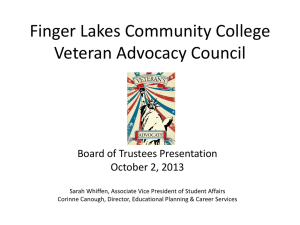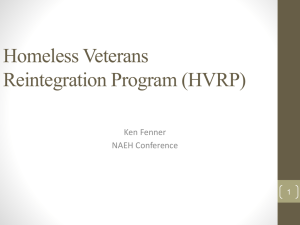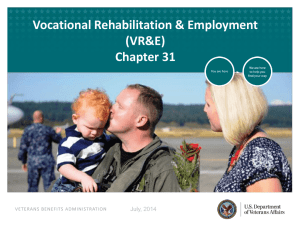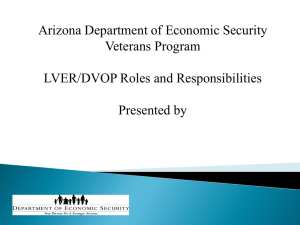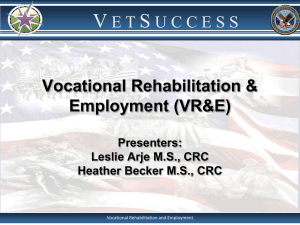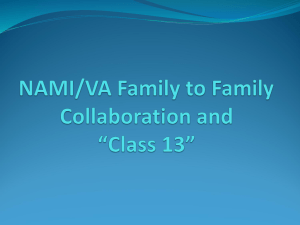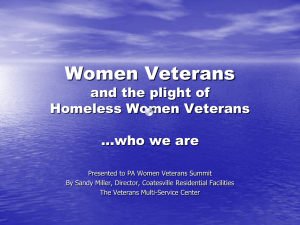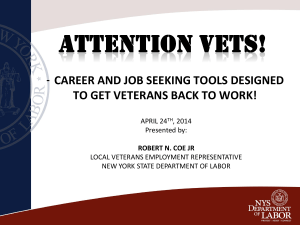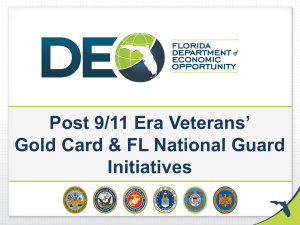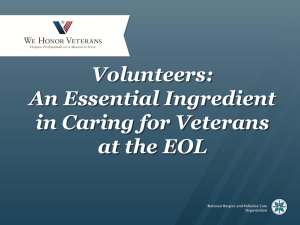PPT - Metro Denver Homeless Initiative
advertisement
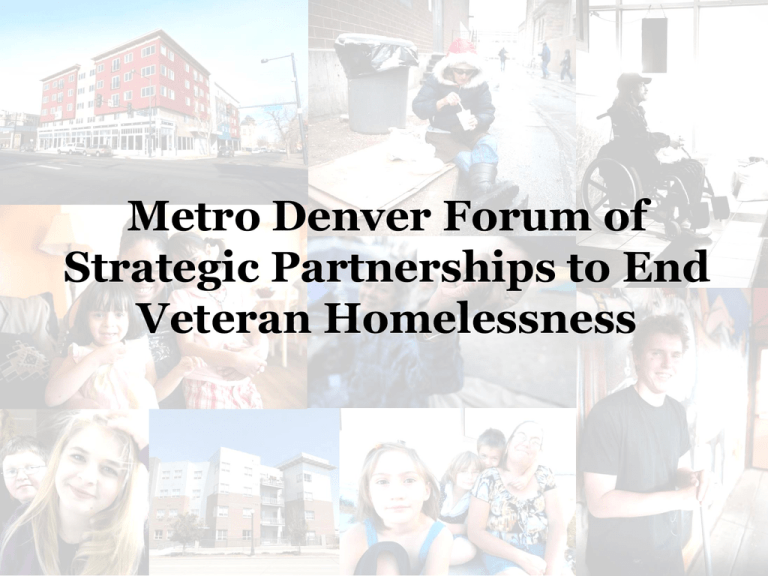
Metro Denver Forum of Strategic Partnerships to End Veteran Homelessness Welcome Welcome “Only a crisis- actual or perceivedproduces real change. When that crisis occurs, the actions that are taken depend on the ideas that are lying around. That, I believe, is our basic function: to develop alternatives to existing policies, to keep them alive and available until the politically impossible becomes the politically inevitable.” - Milton Friedman Objectives: Share vulnerability index survey results Highlight recent housing successes Hear from veterans about their experiences Promote networking & information sharing Identify regional priorities to effectively end veteran homelessness Agenda Ending veteran homelessness by 2015? – Gary Sanford Vulnerability Index Data overview – Katie Symons Panel of Rapid Re-Housing partners – 100 Days Committee Panel of veterans Breakout session with focus groups in areas of Housing, Benefits, Supportive Services, Employment, Health Care, Outreach Presentation of regional priorities – Group facilitators Next steps & Closing remarks Ending Veteran Homelessness by 2015 in seven county area? GARY SANFORD EXECUTIVE DIRECTOR METRO DENVER HOMELESS INITIATIVE National Efforts Vision “President Obama and I are personally committed to ending homelessness among Veterans within the next five years” – Secretary Shinseki Accomplished by •Building Capacity •Creating Solutions Goals • Increase number/variety of housing options including permanent, transitional, contracted, community-operated, and VA operated • Provide more supportive services through partnerships to prevent homelessness, improve employability, and increase independent living for veterans. • Improve access to VA and community based mental health, substance abuse, and supportive services. National Homeless Veteran Numbers Denver-Metro Homeless Veteran Numbers Point In Time The 2011 survey indicated that 11.7% of respondents (603) were homeless veterans The 2012 survey indicated that 12.9% of respondents (710) were homeless veterans GOAL END VETERAN HOMELESSNESS BY 2015 VA Benefits VASH Homeless vouchers Management Information System 100 Days Committee Grant per Diem programs Veteran Trust Fund SOAR VASH vouchers REGIONAL RESOURCES Veteran Stand downs United Veterans Committee Coordinated Entry Veteran Service Organizations NonProfit agencies Colorado Board of Veteran Affairs Community Resource and Referral Center Local initiatives County Veteran Service Officers Supportive Services for Veterans and Families grantees Work Force Centers VA Health Care Ft. Lyon GOAL- END VETERAN HOMELESSNESS BY 2015 Opening Doors – Federal Goal Pathways Home Colorado – State Goal Regional priorities? Voice of those in need Insight from those engaged in addressing needs Alignment to create efficiencies and collaboration Leverage additional resources with collective voice Vulnerability Index Overview KATIE SYMONS CONSULTANT GOVERNOR’S OFFICE SEVEN COUNTY VULNERABILTY INDEX SURVEY OF VETERANS THREE HUNDRED TWENTY SEVEN (327) VETERANS SURVEYED RESULTS ARE BASED ON THE NUMBER OF THOSE SURVEYED AND DOES NOT REPRESENT THE ENTIRE HOMELESS VETERAN POPULATION IN THE SEVEN COUNTY AREA. THE VI IS FOCUSED ON PEOPLE, NOT ONLY NUMBERS. SURVEY ANSWERS ARE SELF REPORTED Risk Factors for Vulnerability More than 6 months homeless AND at least one of the following criteria: -End Stage Renal Disease -History of Cold Weather Injuries -Liver Disease or Cirrhosis -HIV+/AIDS -Over 60 years old -3 or more emergency room visits in prior 3 months -3 or more ER or hospitalizations in prior year -Tri-morbid (mental illness + abusing substances + chronic medical condition) Having one of these conditions will give an individual a rating; the more conditions an individual has, the higher their rating (1-8) Vulnerability Index Interview Questions Veteran Status Discharge, benefits, etc. Demographics Health Risk Indicators Institutional Usage (prison, jail, shelter, foster care) Employment, Income, and Education Youth Risk Involvement Family Risk Involvement Medical Vulnerability 157 out of 327 Veterans are medically vulnerable 48% have at least one risk indicator Vulnerability Score # of Veterans 1= 79 2= 46 3= 22 4= 7 5= 1 6= 2 Vulnerability Index Risk Indicators Risk Indicator # of Veterans Tri-Morbid 84 3x or more to ER in last 3 months 38 3X or more in hospital in last year 18 > 60 years 69 Liver Disease 36 Kidney Disease 14 History of Cold Weather Injury 24 HIV+/AIDS 2 Discharge Status # of Responses 249 40 24 2 4 8 Age Youngest Veteran Oldest Veteran 25 years old 77 years old Youth (25 & Under) 3 Vets Seniors Age 55+ 159 Vets Seniors Age 65+ 27 Vets Gender Transgender, 2 Declined to State, 3 Female, 36 Male, 286 Benefits 350 300 250 11 111 22 65 90 84 55 200 96 150 100 154 204 220 206 140 50 64 108 0 Has Vet Card Connected to VA Med Center Yes Dental No Medical Care Unknown Mental Health Mental Health & Substance Abuse 163 Vets reported receiving some form of mental health treatment 47 reported being held against their will 190 Vets reported using substances 143 Vets reported receiving some form of substance abuse treatment 128 Vets are Dually Diagnosed 200 180 160 140 120 100 80 60 40 20 0 Alcohol Asked to Leave Bad Credit Benefits Problems Disability DV Drugs Eviction Foreclosure Illness Jail Legal Problems Loss of Job Medical Expenses Mental Illness Moved to Find Work Pets Relationship… Rent Risk Factors System Involvement 300 250 200 Yes No Unknown 150 100 50 0 Jail Prison Foster Care Where Interviews were Conducted Locations 140 120 100 80 60 40 20 0 Resides in Which County 250 200 150 100 50 0 Lived Prior to Becoming Homeless (by County) Adams 5% Arapahoe 10% Boulder 5% Broomfield 2% Somewhere else 38% Denver 33% Jefferson 5% Douglas 2% What We Are Doing MANY OF THESE COMMUNITIES ARE TAKING THE KNOWLEDGE FROM THE DATA ADDRESSING GAPS IN SERVICES TO MEET THE NEEDS OF THE MOST VULNERABLE 100 Days committee PANEL PRESENTATION Panel of Rapid Re-Housing Partners 100 DAYS COMMITTEE PANEL CAROLYN JUAREZ – VETERANS ADMINISTRATION SUSAN NINER – COLORADO DIVISION OF HOUSING LORETTA OWENS – DENVER HOUSING AUTHORITY HEATHER POWERS – VETERANS ADMINISTRATION KEVIN RALEIGH – CO COALITION FOR THE HOMELESS SCOTT STRONG - VETERANS ADMINISTRATION SAGE SANTANGELO – METRO DENVER HOMELESS INITIATIVE Local efforts Goals Vision All Coloradans have a place to call home Accomplished by •Building Capacity •Creating Solutions • “Increase voucher utilization for 2008-2012 HUD-VASH vouchers in the next 100 Days, with 100% voucher issuance and 95% of vouchers leased” -100 Days Group • Create housing and accessible services for homeless veterans • Increase retention Denver Metro 100 Day team Team leaders: Carolyn Juarez, HUD-VASH Supervisor Denver VAMC Heather Powers, HUD-VASH Supervisor Denver VAMC Team members: Scott Strong- VAMC Jennifer Daly- VAMC Linda Barringer – Family Tree Rebecca Mayer- Metro Denver Homeless Initiative Brenda Mascarenas – Adams County Housing Authority Toni Manjarrez- Denver Housing Authority Loretta Owens- Denver Housing Authority Katherine Helgerson- Division Of Housing Amanda Guthrie – Boulder County Housing Authority Sage Santangelo – Governors Office Heather Beck- Colorado Coalition for the Homeless/DSOC Kevin Raleigh- CCH/Denver Street Outreach Collaborative Goal vs Results Goal at Launch: House 100 chronically homeless veterans in 100 days, 25 identified from the VI study Baseline: In the 100 days previous to 10/8/12 the Denver Metro HUD- VASH program housed 66 Chronically Homeless Veterans Results @ Day 100: 80 Chronically Homeless Veterans Housed 22 identified through the VI study 18 Additional VI veterans working with case managers, 17 of which have vouchers Baseline vs Results 10085- 0Referral to HUDVASH Admission Admission to HUDVASH to Voucher Issue 33.4 days 56.2 days 10- 20.9 25- 39 days 40- 49.5 days 55- 86.7 days DAYS 70- Voucher Issuance to Lease Up Our Successes in the Denver Metro Fifteen veterans were accepted into the VASH program at the 2012 Denver Stand Down The “100 Veterans in 100 Days” group created to help speed up the VASH voucher issuance process has housed 84 veterans as of January 31st, 23 of whom were identified through the VI A better relationship was forged between Housing authorities and the VA with continued partnership and goal setting How We Improved Collaboration “The collaboration has been amazing.” “The One Stop, in our opinion, was hugely successful. 9 veterans were seen this morning by the VA HUD-VASH team with Division Of Housing very kindly providing space and handling copying and application screening. 9 veterans attended the briefings with Division of Housing and Denver Housing Authority this afternoon and left with housing vouchers in hand.” “What a great example of what can be accomplished when we all come together!” Kintsukuroi (n.) (v. phr.) – “to repair with gold”; the art of repairing pottery with gold or silver lacquer and understanding that the piece is more beautiful for having been broken. Improving Client Experience Veteran who went through the process in 30 days “I had no idea the stand down would lead to this… I met all these great people along the way who were so eager to help… This is the real deal, this is amazing!” “I am amazed at how everything went. I am in an apartment and I am running a bible study class.” “I am so excited to have a kitchen. You don’t understand, when you are living on the street, you never get a hot meal.” “I love it- it’s beautiful. 3 bedrooms and fully furnished, its such a blessing” VI veteran who had been residing for 3 years under a loading dock Areas for Improvement Continue work at landlord recruitment Get ALL communities in the seven-county Denver Metro region involved Establish deeper partnerships with services and organizations that are involved in retention of housing homeless veterans Create VASH as “cool” process with good reputation amongst homeless veterans PANEL OF VETERANS FOCUS GROUPS TASK: IDENTIFY REGIONAL PRIORITIES IN EACH OF THE FOLLOWING AREAS 1. HOUSING 2. BENEFITS 3. SUPPORTIVE SERVICES 4. EMPLOYMENT 5. HEALTH CARE 6. OUTREACH Focus Group Process 1. Discuss priorities in topic areas that will contribute to ending veteran homelessness in seven county area by 2015 2. Brainstorm ideas and place on flip chart 3. Vote on top priorities 4. Rotate after 15 minutes to next group Focus Group Facilitators 1. Housing - Susan Niner (DOH) & Heather Powers (VA) 2. Benefits - John Valvano (VA) & Rebecca Sawyer Smith (VBA) 3. Supportive Services - Dee Drake (Rocky Mountain Human Services) 4. Employment - Nancy Rider (Bayaud Enterprises) 5. Health Care - Cheryl Martin (VA) 6. Outreach - Missy Mish (VA) Presentation of Priorities 1. HOUSING 2. BENEFITS 3. SUPPORTIVE SERVICES- DEE DRAKE 4. EMPLOYMENT - NANCY RIDER 5. HEALTH CARE - CHERYL MARTIN 6. OUTREACH SMITH SUSAN NINER & HEATHER POWERS - JOHN VALVANO & REBECCA SAWYER - MISSY MISH Next Steps • COMPLETE EVALUATION – • Identify interest in assisting with regional efforts • DEVELOP DOCUMENT SUMMARIZING FORUM • DISTRIBUTE TO ATTENDEES • MEET WITH OTHER STAKEHOLDERS IN REGION • PRODUCE DOCUMENT WHICH IDENTIFIES REGIONAL PRIORITIES Special thank you! Jeannie Ritter Veterans Small Group Facilitators
